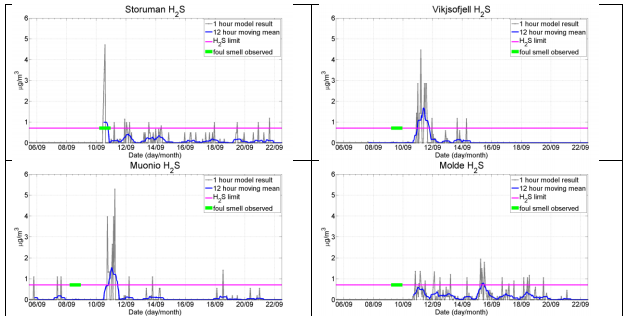Military Scientists Solve the Mystery of the Foul-Smelling Gas That Enveloped Norway, Sweden, and Finland
It’s September 9, 2014, in Molde on the Norwegian coast and the fire brigade are investigating an unusual problem. A foul smell, like rotten eggs or a giant fart, has enveloped the town and the locals are concerned. The next day, newspapers report a similar smell in Storuman County, across the border in Sweden. The smell strikes Finland next, further to the east.

It’s as if a giant cloud of who-knows-what is spreading eastward across the planet.
The culprit isn’t hard to spot across the Norwegian Sea in Iceland. A few weeks earlier, the Bardarbunga volcanic system had begun to erupt beneath Iceland’s most extensive glacier. This generated huge clouds of dust and gas that belched into the atmosphere.
Meteorologists were quick to assume that the smell must be emanating from there. But could this really be true? Clouds disperse naturally in the atmosphere. Could a cloud of gas remain concentrated enough to stink out several countries after traveling the best part of 1,000 kilometers across the planet?
Today, we get an answer thanks to the work of Hakan Grahn and pals at the Swedish Defence Research Agency in Umea. These guys use satellite remote sensing data and a sophisticated model of atmospheric winds to calculate the concentration of culprit gases over Norway, Sweden and Finland in the weeks after the eruption. In particular, they ask whether the concentrations would have been high enough for the human nose to detect.
Grahn and co begin by discussing the method they used to tackle the mystery. They say the most likely culprit is the gas hydrogen sulphide, which is well known for its rotten egg smell. So an important question is how much hydrogen sulphide the volcano produced during its eruption and at what rate.
This leads to an immediate problem. Geologists did not make any direct measurements of hydrogen sulphide levels during the Bardarbunga eruption. However, remote sensing satellites are able to measure the concentration of sulphur dioxide, which is also released in great quantity during eruptions.
Grahn and co say that measurements from other volcanoes suggest that there is about 113 times as much sulphur dioxide as hydrogen sulphide by mass in volcanic gases and that this ratio does not appear to change as the cloud moves through the atmosphere.
So they assume that the Bardarbunga volcano produced a similar ratio and that this did not change as the cloud dispersed.
Another important factor is the state of the atmosphere at the time and in particular the direction of the winds in the following days. For this, they enter known meteorological data into a computer model of the atmosphere called PELLO, which was developed by the Swedish Defence Research Institute to study the dispersion of aerosols and radiation.
Next, Grahn and co used satellite measurements of the amount of sulphur dioxide released by the volcano as input data for the model and let it run to see how the gases would have dispersed.
The results make for interesting reading. The model produces hourly predictions of gas concentrations in the regions of interest in Norway, Sweden and Finland over several days.
Grahn and co say that sulphur dioxide levels over these areas were well below the olfactory threshold that humans can detect. “Based on our simulation results, we conclude that it is unlikely that SO2 is to blame for the foul smell,” they say.
However, the model shows that the concentration of hydrogen sulphide would have exceeded the threshold, or was within an order of magnitude of it, at all the places that reported a foul smell. “We argue that the cause for the foul smell was hydrogen sulphide originating from Bardarbunga,” they conclude.
That’s an interesting result that shows how powerful atmospheric models have become. To be able to predict the concentration of gas in an area hundreds of kilometers from the source in the days and weeks after it was emitted is impressive.
The model isn’t perfect of course. Grahn and co admit that the first two peaks in predicted gas concentration lag the actual peaks by between 12 and 24 hours and that other peaks precede the actual peaks.
But they counter this by pointing out that the one-hour moving average of the predictions produces a result that is consistently within an order of magnitude of the actual value.
Clearly, the Swedish Defence Research Agency knows its stuff when it comes to the dispersion of aerosols.
In some ways that’s not a surprise. Back in 1986, Sweden alerted the world to the unfolding disaster at Chernobyl having been the first to detect the radiation cloud spreading over the country. Since then, the tracking of clouds is a skill it seems to have kept well up to date.
Ref: arxiv.org/abs/1503.05327 : Who Farted? Hydrogen Sulphide Transport From Bardarbunga to Scandinavia
Keep Reading
Most Popular
Large language models can do jaw-dropping things. But nobody knows exactly why.
And that's a problem. Figuring it out is one of the biggest scientific puzzles of our time and a crucial step towards controlling more powerful future models.
How scientists traced a mysterious covid case back to six toilets
When wastewater surveillance turns into a hunt for a single infected individual, the ethics get tricky.
The problem with plug-in hybrids? Their drivers.
Plug-in hybrids are often sold as a transition to EVs, but new data from Europe shows we’re still underestimating the emissions they produce.
Stay connected
Get the latest updates from
MIT Technology Review
Discover special offers, top stories, upcoming events, and more.